2003 Oldsmobile Alero steering wheel
[x] Cancel search: steering wheelPage 200 of 354
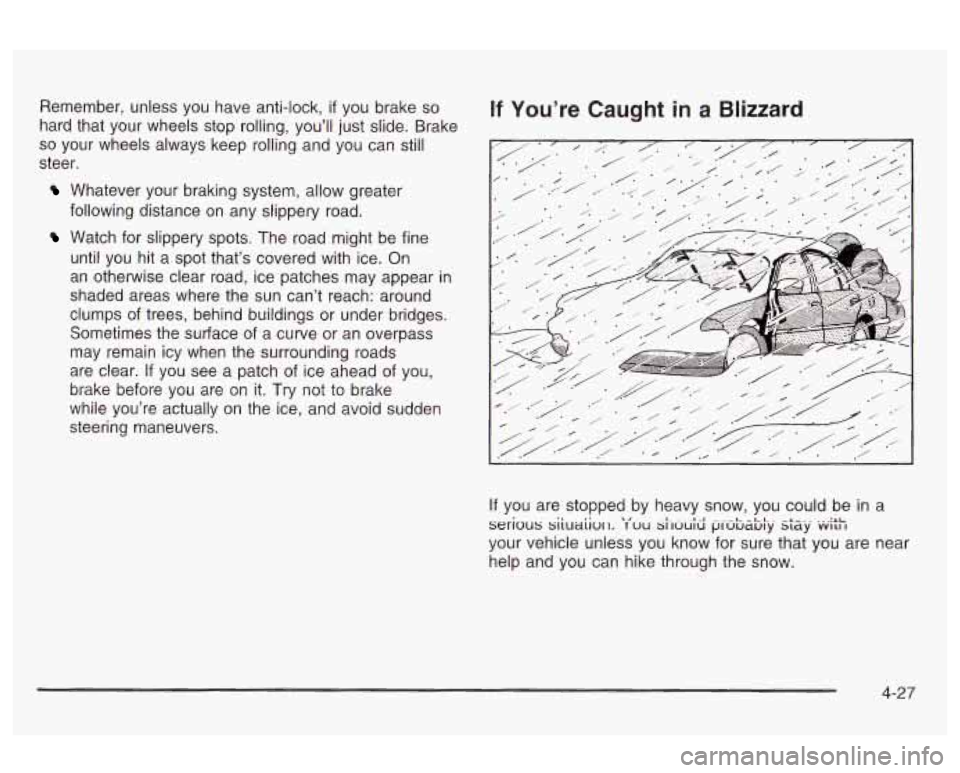
Remember, unless you have anti-lock, if you brake so
hard that your wheels stop rolling, you’ll just slide. Brake
so your wheels always keep rolling and you can still
steer.
Whatever your braking system, allow greater
following distance on any slippery road.
Watch for slippery spots. The road might be fine
until you hit a spot that’s covered with ice. On
an otherwise clear road, ice patches may appear in
shaded areas where the sun can’t reach: around
clumps of trees, behind buildings or under bridges.
Sometimes the surface of a curve or an overpass
may remain icy when the surrounding roads
are clear.
If you see a patch of ice ahead of you,
brake befor2 you are on
it. Try not to brake
while you’re actually on the ice, and avoid sudden
steering maneuvers.
If You’re Caught in a Blizzard
If you are stopped by heavy snow, you could be in a
your vehicle unless you know for sure that you are near
help and you can hike through the snow. seri”us siiuaii”r,. ‘T’uu si-,uui~ pi-u~a~u~.y. stZly LL’jt;?
4-27
Page 203 of 354
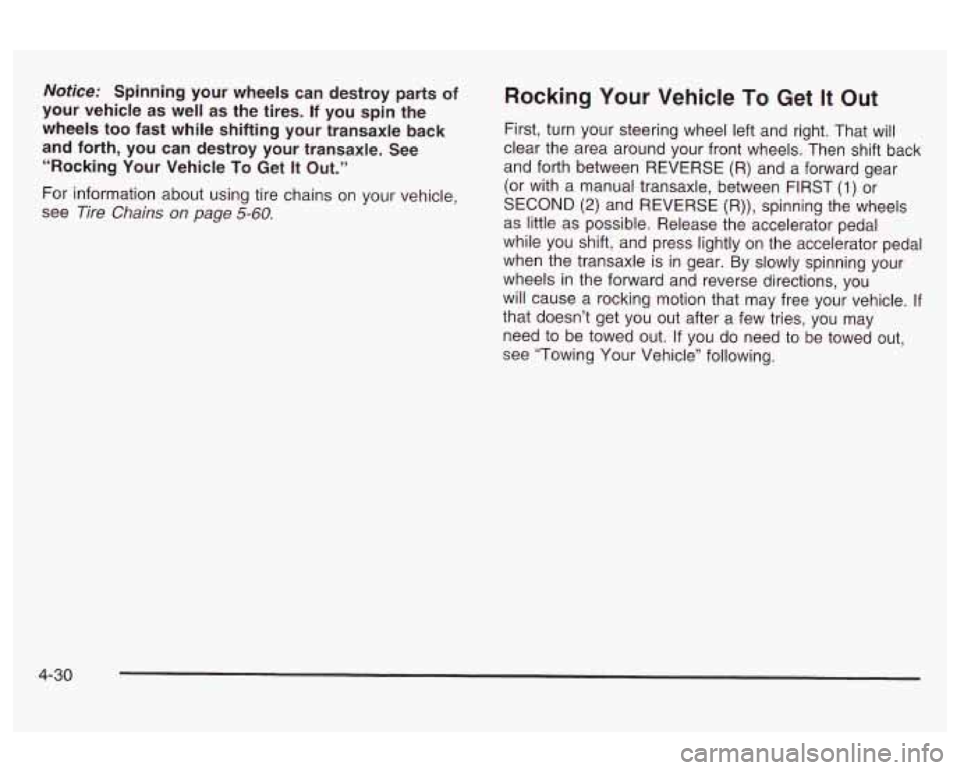
Notice: Spinning your wheels can destroy parts of
your vehicle as well as the tires.
If you spin the
wheels
too fast while shifting your transaxle back
and forth, you can destroy your transaxle. See
“Rocking Your Vehicle
To Get It Out.”
For information about using tire chains on your vehicle,
see Tire
Chains on page 5-60.
Rocking Your Vehicle To Get It Out
First, turn your steering wheel left and right. That will
clear the area around your front wheels. Then shift back
and forth between REVERSE
(R) and a forward gear
(or with a manual transaxle, between FIRST
(1) or
SECOND
(2) and REVERSE (R)), spinning the wheels
as little as possible. Release the accelerator pedal
while you shift, and press lightly on the accelerator pedal
when the transaxle is in gear. By slowly spinning your
wheels in the forward and reverse directions, you
will cause a rocking motion that may free your vehicle.
H
that doesn’t get you out after a few tries, you may
need to be towed out. If you do need to be towed
out
see “Towing Your Vehicle’’ following.
4-30
Page 206 of 354
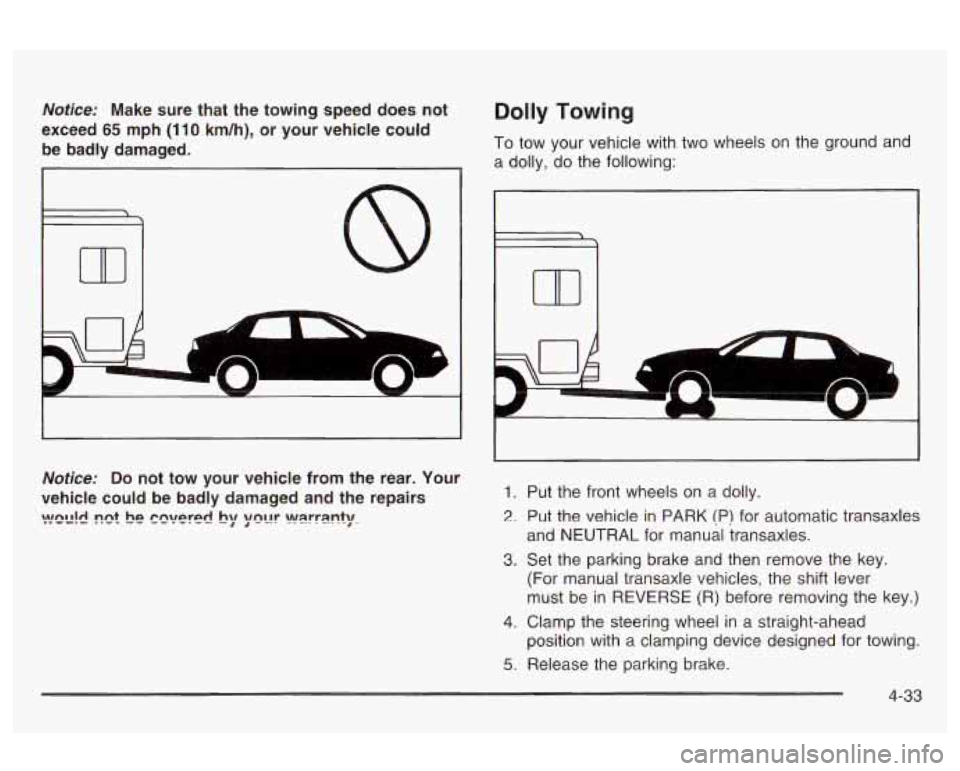
Notice: Make sure that the towing speed does not
exceed
65 mph (1 10 km/h), or your vehicle could
be badly damaged.
Dolly Towing
To tow your vehicle with two wheels on the ground and
a dolly, do the following:
Notice:
Do not tow your vehicle from the rear. Your
vehicle could be badly damaged and the repairs
!?!!X!d !?e! he Pn~!PlPc! by ;mL!r wsrrsnty.
1. Put the front wheels on a dolly.
2. Put the vehicle in PARK (P) for automatic transaxles
and NEUTRAL for manual transaxles.
3. Set the parking brake and then remove the key.
(For manual transaxle vehicles, the shift lever
must be in REVERSE
(R) before removing the key.)
4. Clamp the steering wheel in a straight-ahead
position with a clamping device designed for towing.
5. Release the parking brake.
4-33
Page 213 of 354

Driving with a Trailer
Towing a trailer requires a certain amount of experience.
Before setting out for the open road, you’ll want to get
to know your rig. Acquaint yourself with the feel of
handling and braking with the added weight of the trailer.
And always keep in mind that the vehicle you are
driving is now a good deal longer and not nearly as
responsive as your vehicle is by itself.
Before you start, check the trailer hitch and platform
(and attachments), safety chains, electrical connector,
lamps, tires and mirror adjustment.
If the trailer has
electric brakes, start your vehicle and trailer moving and
then apply the trailer brake controller by hand to be
sure the brakes are working. This lets you check your
electrical connection at the same time.
During your trip, check occasionally to be sure that the
load is secure, and that the lamps and any trailer
brakes are still working.
Following Distance
Stay at least twice as far behind the vehicle ahead as
you would when driving your vehicle without a trailer.
This can help you avoid situations that require
heavy braking and sudden turns.
Passing
You’ll need more passing distance up ahead when
you’re towing a trailer. And, because you’re a good deal
longer, you’ll need to go much farther beyond the
passed vehicle before you can return to your lane.
Backing Up
Hold the bottom of the steering wheel with one hand.
Then, to move the trailer to the left, just move that hand
to the left. To move the trailer to the right, move your
hand to the right. Always back up slowly and,
if possible,
have someone guide you.
Making Turns
Notice: Making very sharp turns while trailering
could cause the trailer to come in contact with the
vehicle. Your vehicle could be damaged. Avoid
making very sharp turns while trailering.
When you’re turning with a trailer, make wider turns
than normal.
Do this so your trailer won’t strike
soft shoulders, curbs, road signs, trees or other objects.
Avoid jerky or sudden maneuvers. Signal well in
advance.
4-40
Page 276 of 354
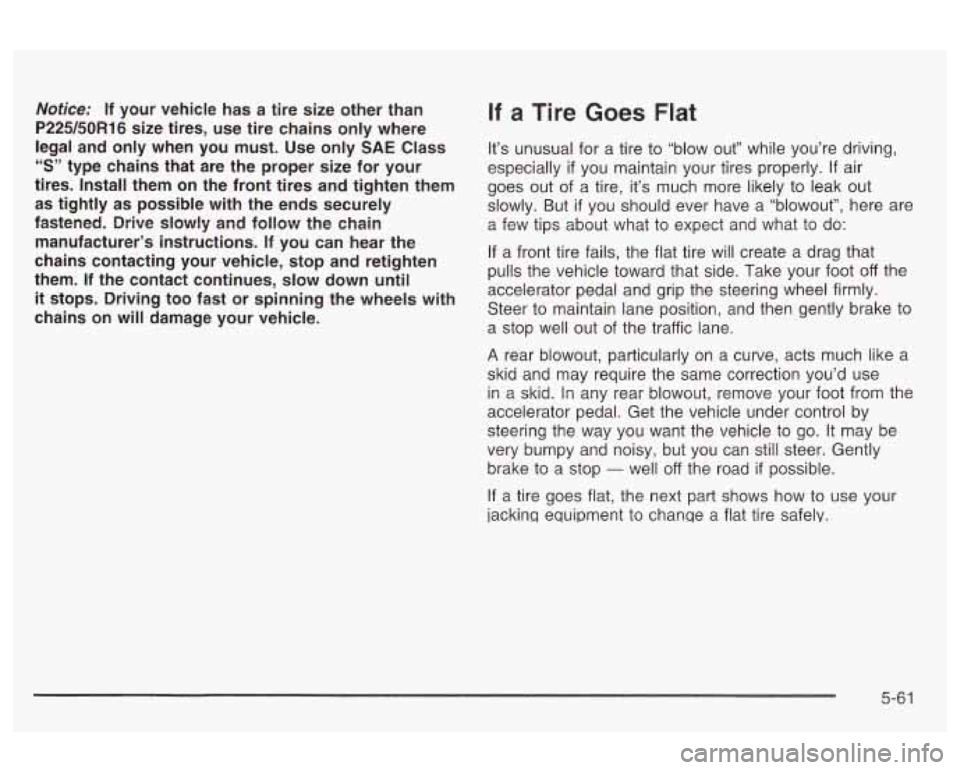
Notice: If your vehicle has a tire size other than
P225/50R16 size tires, use tire chains only where
legal and only when you must. Use only
SAE Class
“S” type chains that are the proper size for your
tires. Install them on the front tires and tighten them
as tightly as possible with the ends securely
fastened. Drive slowly and follow the chain manufacturer’s instructions.
If you can hear the
chains contacting your vehicle, stop and retighten
them.
If the contact continues, slow down until
it stops. Driving too fast or spinning the wheels with
chains on will damage your vehicle.
If a Tire Goes Flat
It’s unusual for a tire to “blow out” while you’re driving,
especially
if you maintain your tires properly. If air
goes out of a tire, it’s much more likely to leak out
slowly. But
if you should ever have a “blowout”, here are
a few tips about what to expect and what to do:
If a front tire fails, the flat tire will create a drag that
pulls the vehicle toward that side. Take your foot off the
accelerator pedal and grip the steering wheel firmly.
Steer to maintain lane position, and then gently brake to
a stop well out of the traffic lane.
A rear blowout, particularly on a curve, acts much like a
skid and may require the same correction you’d use
ir; a skid. In any rear blowoi:, rem0t.e yoi; foot from the
accelerator pedal. Get the vehicle under control by
steering the way you want the vehicle to go. It may be
very bumpy and noisy, but you can still steer. Gently
brake to a stop
- well off the road if possible.
If a tire goes flat, the next part shows how to use your
iackinq equipment to chanqe a flat tire safely.
5-61
Page 298 of 354
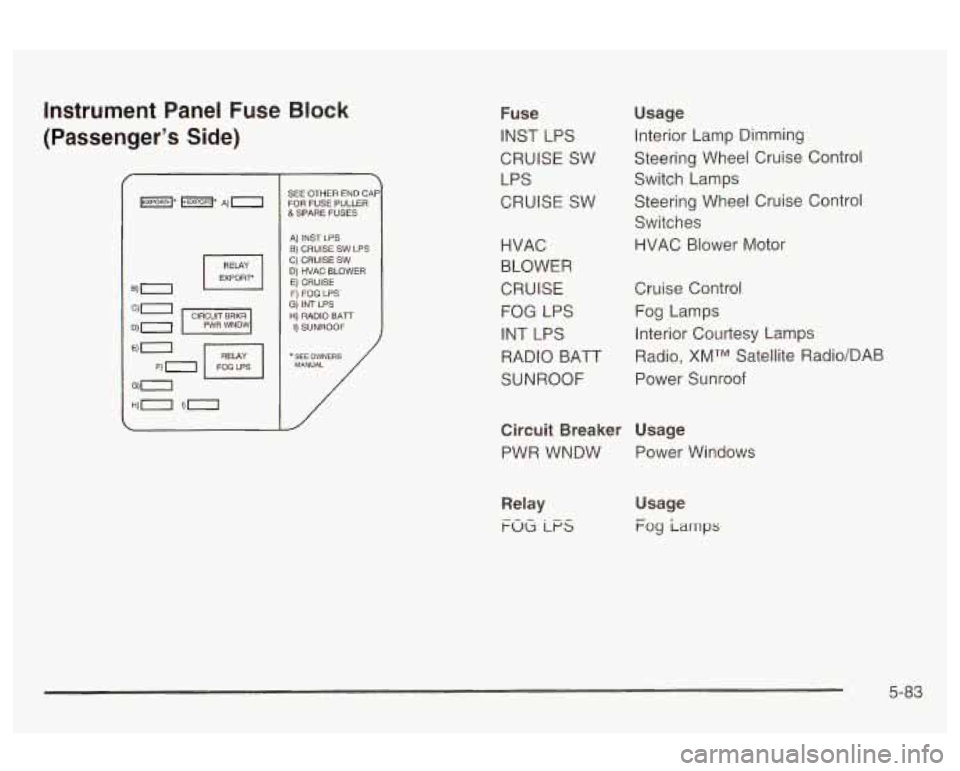
Instrument Panel Fuse Block
(Passenger’s Side)
SEE OTHER END CAF FOR FUSE PULLER &SPARE FUSES
A) INST LPS
C) CRUISE
SW B) CRUISE SW LPS
0) HVAC BLOWER E) CRUISE F) FOG LPS G) INT LPS H) RADIO BATr I) SUNROOF
* SEE OWNERS MANUAL /
1’
Fuse
INST LPS
CRUISE SW LPS
CRUISE SW Usage
Interior Lamp Dimming
Steering Wheel Cruise Control
Switch Lamps
Steering Wheel Cruise Control
Switches
HVAC Blower Motor
HVAC
BLOWER
CRUISE Cruise Control
FOG LPS
Fog Lamps
INT LPS Interior Courtesy Lamps
RADIO BAT Radio, XMTM Satellite Radio/DAB
SUNROOF Power Sunroof
Circuit Breaker Usage
PWR WNDW Power Windows
Relay
FOG LFS
Usage
Fog iarnps
5-83
Page 345 of 354
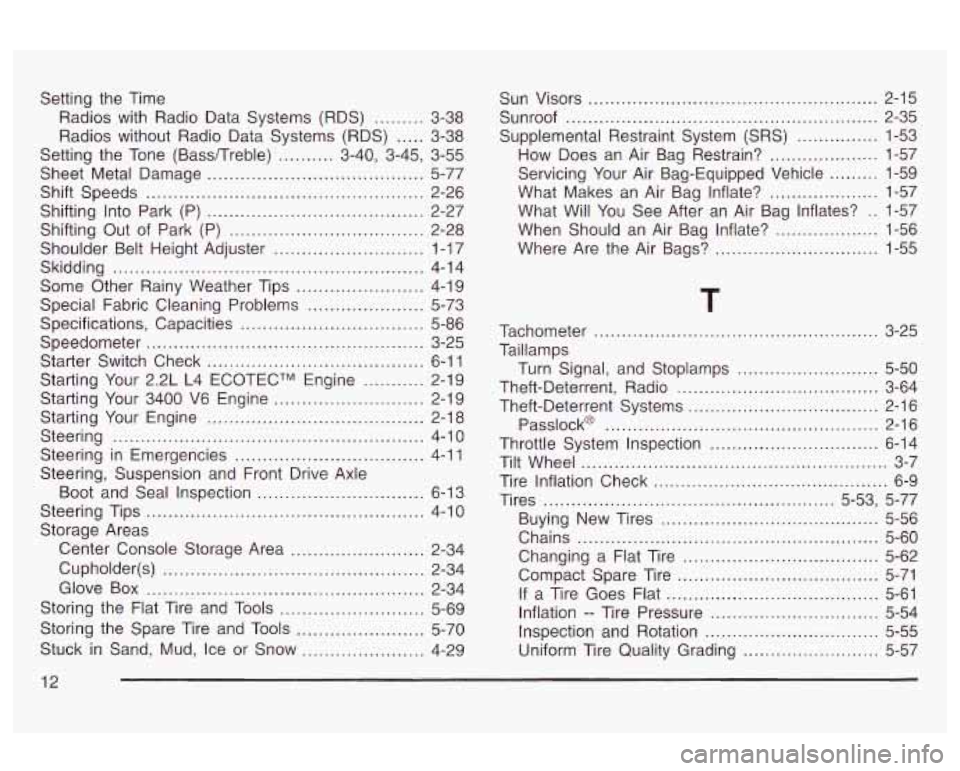
Setting the Time
Radios with Radio Data Systems (RDS)
......... 3-38
Radios without Radio Data Systems (RDS)
..... 3-38
Setting the Tone (BassTTreble)
.......... 3.40. 3.45. 3-55
Sheet Metal Damage
....................................... 5-77
Shift Speeds
.................................................. 2-26
Shifting Into Park (P)
....................................... 2-27
Shifting Out of Park (P)
................................... 2-28
Shoulder Belt Height Adjuster
........................... 1-1 7
Skidding
........................................................ 4-1 4
Some Other Rainy Weather Tips
....................... 4-19
Special Fabric Cleaning Problems
... ....... 5-73
Specifications, Capacities
.................. ... 5-86
Speedometer
.............................................. 3-25
Starter Switch Check
....................................... 6-1 1
Starting Your 2.2L L4 ECOTECTM Engine ........... 2-19
Starting Your 3400
V6 Engine ........................... 2-19
Starting Your Engine
................................... 2-18
Steering
............................................. ... 4-10
Steering in Emergencies
.................................. 4-1 1
Steering, Suspension and Front Drive Axle
Boot and Seal Inspection
.............................. 6-13
Steering Tips
....................................... , ... 4-10
Storage Areas
Center Console Storage Area
........................ 2-34
Cupholder(s)
............................................... 2-34
Glove Box
.................................................. 2-34
Storing the Flat Tire and Tools
.......................... 5-69
Storing the Spare Tire and Tools
....................... 5-70
Stuck in Sand, Mud, Ice or
Snow ...................... 4-29 Sun
Visors
................................................. 2-15
Sunroof
..................................................... 2-35
Supplemental Restraint System
(SRS) ........... 1-53
How Does an Air Bag Restrain?
.................... 1-57
Servicing Your Air Bag-Equipped Vehicle
......... 1-59
What Makes an Air Bag Inflate?
.................... 1-57
What Will You See After an Air Bag Inflates?
.. 1-57
When Should an Air Bag Inflate? ................... 1-56
Where Are the Air Bags?
.............................. 1-55
Tachometer
.................................................... 3-25
Taillamps Turn Signal, and Stoplamps
.......................... 5-50
Theft-Deterrent, Radio ..................................... 3-64
Theft-Deterrent Systems
................................... 2-16
Passlock@
.................................................. 2-16
Throttle System Inspection
............................... 6-14
Tilt Wheel
........................................................ 3-7
Tire Inflation Check
........................................... 6-9
Tires
..................................................... 5-53, 5-77
Buying New Tires
........................................ 5-56
Chains
....................................................... 5-60
Changing a Flat Tire
.................................... 5-62
Compact Spare Tire
..................................... 5-71
If a Tire Goes Flat
....................................... 5-61
Inflation
-- Tire Pressure ............................... 5-54
Inspection and Rotation ................................ 5-55
Uniform Tire Quality Grading ......................... 5-57
12
Page 347 of 354

Ventilation Adjustment ...................................... 3-22
Vinyl
............................................................. 5-74
Visor Vanity Mirror
.......................................... 2-15
Visors
........................................................... 2-1 5
Warning Lights. Gages and indicators ................ 3-23
Warnings
Hazard Warning Flashers
............................... 3-6
Other Warning Devices
.................................. 3-6
Safety and Symbols
......................................... iii
Vehicle Damage .............................................. iv
Washer Fluid, Low Warning Light
...................... 3-36
Washing Your Vehicle
...................................... 5-75
Weatherstrip Lubrication
................................... 6-1 0
Weight of the Trailer ........................................ 4-37
Weight
of the Trailer Tongue ............................. 4-38
What Kind
of Engine Oil to Use ........................ 5-18
What to Do with Used Oil
................................ 5-20
What to Use
.......................................... 5-24, 5-36
Wheels Alignment and Tire Balance
.......................... 5-58
Replacement
............................................... 5-59
When to Add Engine Oil
.................................. 5-17
When to Change Engine Oil
(GM Oil Life SystemTM)
................................ 5-19
When to Check
.............................................. 5-54
When to Check and What to Use
..................... 5-23 When
to Check Power Steering Fluid
................ 5-35
When You Are Ready to Leave After Parking
on a Hill
..................................................... 4-42
Where to Put the Restraint
........... ............ 1-41
Window Lockout
............................................. 2-15
Windows
....................................................... 2-14
Manual
...................................................... 2-14
Power
........................................................ 2-15
Windshield and Wiper Blades
....................... 5-76
Windshield Washer
..................................... 3-10
Fluid
.......................................................... 5-36
Windshield Washer Fluid Level Check
................. 6-9
Windshield Wiper
Blade Replacement
...................................... 5-52
Fuses
........................................................ 5-81
Windshield Wipers
............................................ 3-9
Winter Driving
......... ................................ 4-25
Wiper Blade Check
..... ........ ........ 6-10
Why Safety Belts Work
.................................... 1-10
X
XMTM Satellite
Radio Antenna System ................ 3-67
XMTM Satellite Radio Service
............................ 3-65
Your Vehicle and the Environment
....................... 6-2
14